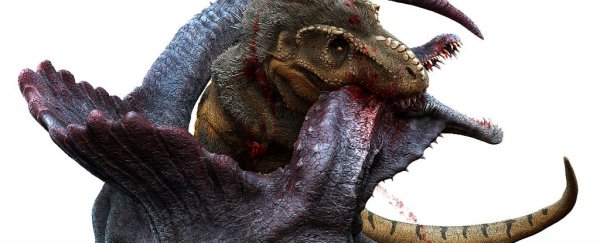It's a question many of us may have pondered - particularly those of us who've seen any of the Jurassic Park films: how easy is it to outrun a Tyrannosaurus rex in a straight race?
Well, ponder no longer, because palaeontologists working at a site in Wyoming have applied some maths to a series of T. rex footprints, and have come up with an answer to this question of the ages.
Under the leadership of University of Alberta palaeontologist Scott Persons, the researchers have been analysing the spacing of dinosaur footprints left behind on an ancient riverbed in Glenrock - footprints that they believe were created by a young T. rex known controversially as Nanotyrannus lancensis.
The measurement of the footprints (47 cm by 36.8 cm or 18.5 inches by 14.5 inches) and the layout of the toes helped them to determine which kind of prehistoric creature they were dealing with.
Based on the position of the tracks, and what we know about the height of this kind of dinosaur from museum fossil collections, it's possible to work out how fast the T. rex was going: between 4-8 km/h (2.7 and 5 mph) the palaeontologists reckon, although the dino was only at a brisk walking pace at the time. The average walking speed for a human is around 4.8 km/h (3 mph), while a standard jogging speed is between 8-9 km/h (5-6 mph).
In other words, yes you probably could outrun - and definitely out-drive - a lumbering Tyrannosaurus rex.
"Biomechanical studies of tyrannosaur bones, combined with calculations of their musculature and computer models, tell us that tyrannosaurs were more suited for walking and probably could not outrun, say, a jeep," fossil expert Tony Martin, who wasn't involved in the research, told Discovery. "Although that might sound boring, it's actually quite exciting, because it helps us more accurately visualise tyrannosaurs as real, living animals in their ecosystems about 70 million years ago."
While the calculations match previous models run via computer software, they don't tell us much about how these dinosaurs hunted. Even at a slow speed, their stride would be larger than the herbivores we think they chased at the time, but what researchers can't be sure of yet is whether these beasts did indeed stick to trotting around, or would instead break into a faster sprint to catch their prey.
Still, it's best to err on the side of caution if someone should create a dinosaur theme park or indeed a time-travelling device. "Would I have challenged T. rex to a race, just to see how fast it could go? Probably not," added Martin.
The team's work has been published in Cretaceous Research.
